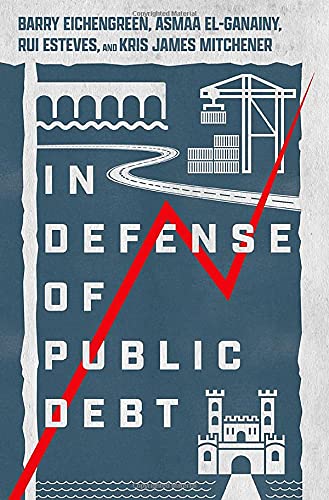Kaetana Numa: “In Defense of Public Debt” by Barry Eichengreen et al.

Barry Eichengreen is Professor of Economics and Political Science at the University of California, Berkeley. His economic and economic history research focuses on monetary and financial systems, and he is an author of over 20 books, among them Golden Fetters: The Gold Standard and the Great Depression, 1919–1939, Globalizing Capital: A History of the International Monetary System, and The European Economy since 1945: Coordinated Capitalism and Beyond.
Eichengreen’s and his co-authors’ In Defense of Public Debt is organised into 14 chapters, tracing the history of public debt from its earliest origins in the Greek city–states and the Roman Republic, and arriving at the Covid economic scene (the book was published in September 2021). Each chapter focuses on a specific time period with its particular theme and relevant cases studies. For example, Chapter 3 “States and the Limits of Borrowing” recounts the fiscal and political developments primarily in the European states in the sixteenth–eighteenth centuries that augmented commitment to repay debts and enabled more borrowing; it also identifies certain ‘impediments’ (such as fiscal decentralization and competition) that limited states’ abilities to borrow more.
The book reads like a history of public debt, and in that respect, it presents a thorough historical account of the topic. In addition to analysing the overall levels of public debt, the authors also examine the development of the actual methods of public borrowing, creditors’ rights and representation, and the role of banks and various intermediaries. Readers may be pleased to find that the history of taxation and monetary systems are interwoven into this historical narrative of public debt.
In the introduction chapter, the authors promised to give a “balanced account” of public debt; curiously, “balanced” was meant as “placing more weight on the positive aspects than is typical of the literature” (page 5). Even so, the positive aspects put forward in this book are often vague. There is surprisingly little discussion of the use and efficiency of public debt, beyond the general recognition that states have historically relied on borrowing to fund wars, invest in infrastructure, social services, and, more recently, to bail out the financial sector and bankroll public services during a pandemic. The readers are expected to take it for granted that debt is used to fund vital causes. Yet are all uses of debt equally sound and defensible? This question is mostly ignored, except for some hints that spending on general consumption would not be as desirable as spending on investment. It admits that even though budget surpluses should be pursued to reduce debt when the economy is growing, this is difficult to achieve in practice. When it comes to generating primary surpluses, the book’s proposed answer is always higher tax, rather than spending cuts.
Eichengreen’s book leaves one with an impression that there is economic evidence of a positive relationship between public debt and economic growth. This relationship is meant to act as a “positive feedback” in the economic growth models, whereby “The link from public debt and its role in financial development to faster growth, and from faster growth back to financial deepening and economic development, is just such a feedback” (page 212). Among other things, we learn that with respect to foreign borrowing in the nineteenth century, “Countries that borrowed more invested more and grew faster on average, suggesting that issuing sovereign debt paid” (page 7), with a concession in the Notes section that evidence of a positive link “is weaker for the twentieth century” (page 228). However, a more balanced account of public debt would have had to mention the ample economic evidence of a negative relationship between high levels of public debt and economic performance. For example, most recent economic studies on this subject identified a negative link between high public debt and economic growth; there is also a tipping point threshold (in the range of 70% to 100% of GDP) when debt begins to have a significantly detrimental effect on growth (see, for example, De Rugy, V. and Salmon, J. Debt and Growth: A Decade of Studies).
This is not to say that Eichengreen’s book does not mention any negative aspects of public debt, as it does recount examples of heavy interest payments, defaults, and, in worst cases, loss of sovereignty. Yet even though the various debt default episodes make for interesting reading, they ignore the subsequent harm caused to society, and do not show the full extent of the social and economic miseries experienced during such episodes. Moreover, the negative aspects are often presented as examples of debt mismanagement or perils of public debt, even though they could in fact point to more systemic issues.
The question of morality of accumulating public debt does appear towards the end of this book, yet the moral arguments against public debt, as well as those making these arguments, are presented here in a dismissive tone: “They fret”, “worry”, “complain” (page 181). Readers appreciating the vital link between market and ethics may find it strange to see moral objections to public debt being dismissed outright as not belonging to the economic realm, with the authors suggesting that “there was also another view, in which debt was viewed in economic rather than moralistic terms, and where its issuance was seen as a solution to problems, not as their source” (page 182). Yet as already noted above, plenty of recent economic evidence shows high levels of public debt having a detrimental effect on economic performance; thus, even when analysed in economic terms, debt is hardly a solution. Meanwhile, moral issues stemming from public debt, such as the distributional and intergenerational justice issues, raise serious dilemmas that deserve to be answered.
The lack of a response to these moral arguments is but one of the questions left unanswered. Another one, just as problematic, relates to how to deal with rising debt in the future. This book does not engage with the alarming long–term projections of public debt. For example, the UK public sector net debt as a share of GDP is forecast to quadruple by 2070 to 418% of GDP (Office for Budget Responsibility Fiscal Sustainability Report – July 2020). Developed countries will be faced with growing social security and healthcare costs (which have not been pre–funded and are further hampered by unfavourable demographic circumstances), raising more issues for the policymakers. Even with respect to the immediate public debt situation, Eichengreen’s book concedes “there are no simple solutions” (page 223), noting the possibility of runaway inflation (even though the book was sceptical about such a development), the dangers of higher interest rates, and the limited prospects of economic growth or budget surpluses.
Unfortunately, the fears of sharp inflation and rising interest rates have already materialised by mid–2022. This brings us back to the moral issues with debt, namely, to the responsibility of architects of fiscal and monetary policy for the economic pain presently being inflicted upon the wider society. Eichengreen’s book referred to debt as a temptation to which politicians may succumb to. This demonstrates that there is more to public debt than pure economics, and that those seeking a way out of the looming debt crisis should not dismiss the ethical arguments against public debt after all.
Those looking for a truly balanced account of public debt will need to look elsewhere but there is much of value in this book for those interested in economic history.
“In Defense of Public Debt” by Barry Eichengreen, Asmaa El–Ganainy, Rui Esteves and Kris James Mitchener was published in 2021 by Oxford University Press (ISBN-13: 9780197577899). 320pp.
 Kaetana Numa, PhD is Research Fellow at the Centre for the Study of Governance and Society, King’s College London.
Kaetana Numa, PhD is Research Fellow at the Centre for the Study of Governance and Society, King’s College London.
